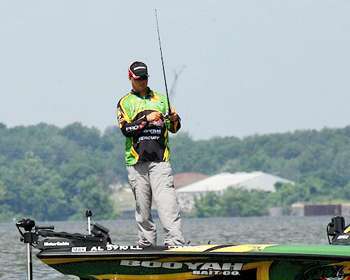
On any given day, it's possible to catch a bass or two by tying on the first lure that strikes your fancy. However, in order to up the odds and make your catch rate more consistent, it's a better idea to have a method to the madness, rather than going with the first bait you see.
Elite Series pro Tim Horton is quick to point out that if you're not attempting to "match the hatch," you're likely doing little more than trying to get lucky. "There are all different sizes of shad but it's pretty easy to boil it down to either big or small," he point out.
Using "big" or "small" as his baseline for bait selection, Horton's "match the hatch" methodology is about as basic as it gets. "I just think it's always important, any time of the year, to match your bait size to the size of the baitfish bass are preying on," he explains, pointing out that bigger shad typically equals bigger bass in the area. "If you can find the bigger shad, there's no doubt that you're generally going to be around bigger bass."
The key, Horton allows, is in finding the lure that best matches the shad you're around. "If you find the bigger shad, you're going to want to go with a bigger spinnerbait or crankbait," he says. "Likewise, for smaller shad your baits should be smaller as well."
Horton maintains that finding smaller shad during the colder months is often times easier to do, given their relation to the surface of the water. "Typically, smaller shad will be up near the surface of the water as the water begins to cool down," he says, pointing out that when you find smaller shad, you're usually going to be around schooling fish.
In order to match his bait to the smaller shad size, Horton will downsize to smaller lures, such as a topwater Pop-R or a smaller spinnerbait with No. 3 blades. "Again, you have to have a bait that is as close as possible to the size of the baitfish," he says.
So, bigger shad equals bigger baits, while smaller shad equals smaller baits. When both sizes of shad are present in a body of water, which size should an angler concentrate on finding? "My strategy for fall and winter bass fishing is to basically focus where the bigger shad live, which means fishing offshore," Horton says.
"I'm going to be fishing bigger swimbaits deep, slow rolling a big spinnerbait or throwing a deep diving crankbait. I will always trade numbers for size, so that's a pretty simple decision for me to make."
Targeting small shad that are located in the upper half of the water column may produce more bites, but the Alabama pro points out that as a tournament angler, he's been burned too many times by the easy bite. "Catching schooling bass is some of the most fun you can have," he maintains. "The problem is that they're generally going to be smaller fish. For the tournament angler, you have to focus on getting the bigger bites."
(Provided exclusively to BASS Insider by Z3 Media)




